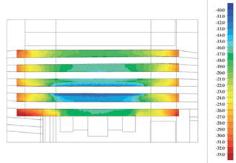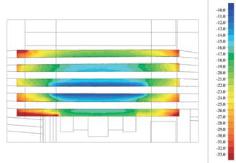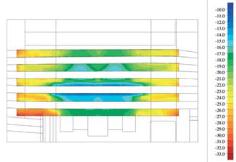SEO Version




62
fg 8
fg 7.1 The sound level under a fat cover.
fg 7.2 The sound level under a simple arch.
fg 7.3 The sound level of the competition design, identical
to fg 4.2, see there also.
noise within the separate modules, and suppresses the sound dispersion over the
whole area. The noise in the separate modules is largely absorbed because of the
perforated roof structure.
The perforated sheeting of the covering is an important element with regard to
noise control. In an ideal case it is 100% absorbent, promoting the same favourable
conditions of open air sound dispersion, without projection of sound into the direct
surroundings. This optimum value can only be approximated since a given surface
is never a full 100% absorbent. The proposed solution, using perforated sheeting, is
a compromise between sound absorption properties and ease of construction and
maintenance. The noise absorption is realised combining profiled roof sheeting with
perforated sides (perforation level of 30%), with a soundproofing filling covering
both the grooves and, in a reduced density, the entire area. This soundproofing filling
serves as a thermal insulation against cold surface condensation on the underside
of the aluminium weather sealing as well. Figure 8 shows a schematic presentation
of the structure of this roof.
To demonstrate the effectiveness of the soundproofing, calculations of sound
dispersion were made for a cover without soundproofing, as well as for a cover with
the proposed soundproofing.
Figures 9.1 - 9.2 indicate the distribution of the sound pressure levels on the platforms,
measuring the effect of soundproofing on noise dispersion.
Two situations are presented: a cover with soundproofed roof, and one without.
Both calculations were based on a sound source on track 3, length 100 m, Lw = 0 dB/m
(fig. 3)
.
Figure10showsasummaryof bothsoundcardcalculationresults inagraph indicating
the cumulative dispersion of the sound levels on the platforms. It is obvious that a
soundproofed roof has a positive effect on noise levels under the cover. The average
decrease in sound levels is 3‑4 dB(A). The total area of the more quiet zones during
aluminum roof
omega profle
thermal insulation and
acoustic absorption
roof clips
groove flling
(acoustic absorption)
perforated plate profle
Powered by FlippingBook Publisher

